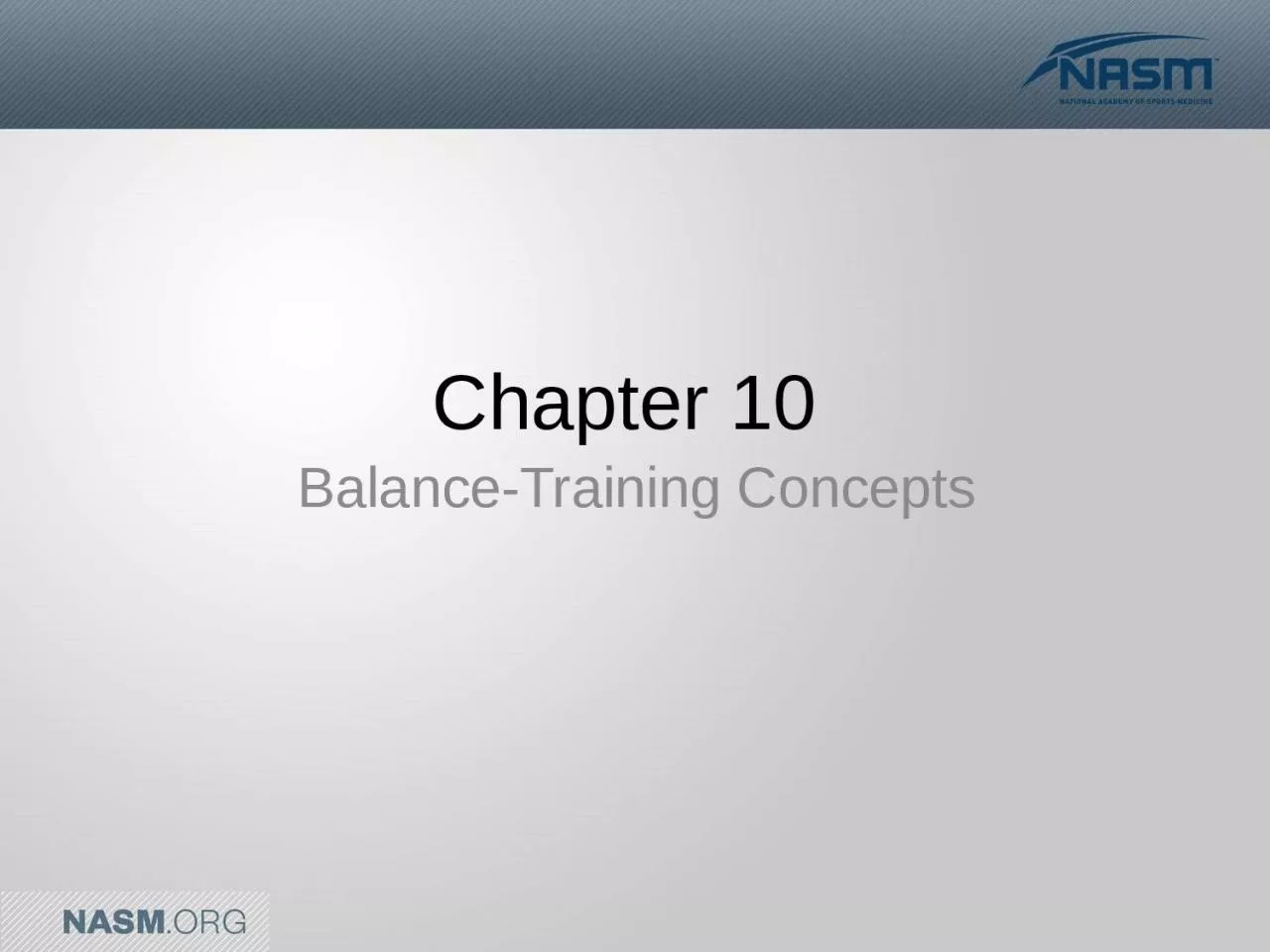

Purpose To provide the fitness professional with a fundamental level of knowledge regarding the use of balance stabilization training concepts To allow the fitness professional to select and administer the appropriate balancetraining protocol for all clients ID: 1036309
Download Presentation The PPT/PDF document "Chapter 10 Balance-Training Concepts" is the property of its rightful owner. Permission is granted to download and print the materials on this web site for personal, non-commercial use only, and to display it on your personal computer provided you do not modify the materials and that you retain all copyright notices contained in the materials. By downloading content from our website, you accept the terms of this agreement.
1. Chapter 10 Balance-Training Concepts
2. PurposeTo provide the fitness professional with a fundamental level of knowledge regarding the use of balance stabilization training concepts.To allow the fitness professional to select and administer the appropriate balance-training protocol for all clients.
3. ObjectivesAfter this presentation, the participant will be able to:Define balance and describe its role in performance and injury risk.Discuss the importance of balance training. Design a progressive balance-training program for clients in any level of training.Perform, describe, and instruct various balance-training exercises.
4. Concepts in Balance The Importance of BalanceMaintaining balance is a key to all functional movements.Often thought of as a static process Functional balance is static and dynamic.The ability to reduce force at the right joint, at the right time, and in the right plane of motion requires optimum levels of functional dynamic balance and neuromuscular efficiency.
5. Balance Mechanism Balance training should constantly stress an individual’s limits of stability (balance threshold). Limit of stability: The distance outside of the base of support to which the client can go without losing control of his or her center of gravity.This threshold must be constantly stressed in a multiplanar, proprioceptively enriched environment using functional movement patterns.
6. Balance MechanismProprioceptively Enriched EnvironmentsUnstable yet controllable environment.Must use the appropriate progressions and correct technique at varying speeds to facilitate maximal sensory input to the central nervous system.Proper progression:FloorBalance beamHalf foam rollFoam padBalance disc
7. Scientific RationaleBenefitsImproves dynamic joint stabilization. The ability of the kinetic chain to stabilize a joint during movement.The main goal is to continually increase the client’s awareness of his or her limit of stability (kinesthetic awareness) by creating controlled instability.
8. Balance and Joint DysfunctionMuscle imbalances, joint dysfunctions, pain, and swelling can lead to altered balance. 80% of the adult population experiences low-back pain.80,000–100,000 anterior cruciate ligament (ACL) injuries occur annually. More than two million ankle sprains occur every year. Thus, the majority of the clients that fitness professionals work with may have decreased neuromuscular efficiency and balance.
9. Balance and Joint Dysfunction
10. Balance Training Effects on InjuryBalance exercises are a frequent component of integrated ACL injury prevention programs, which have shown promise in reducing the rate of ACL injury.On the basis of a recent systematic review, balance training programs performed for at least 10 minutes a day, 3 times per week for 4 weeks, appear to improve both static and dynamic balance ability.
11. Designing a Balance ProgramExercise SelectionSafeProgressiveEasy to hardSimple to complexKnown to unknownStatic to dynamicProprioceptively challengingFloorBalance beamHalf foam rollFoam pad
12. VariablesPlane of motionFrontalSagittalTransverseRange of motionFullPartialEnd-range
13. Levels of Balance TrainingThere are three levels of training within the National Academy of Sports Medicine’s OPT™ model.StabilizationStrengthPower
14. Balance Stabilization ExercisesExercises involve little joint motion and are designed to improve reflexive joint stabilization contractions to improve joint stability. When the body is placed in unstable environments, it must react by contracting the right muscles at the right time to maintain balance.
15. Balance Strength ExercisesMore dynamic eccentric and concentric movement through a full range of motion.Require dynamic control in mid-range of motion with isometric stabilization at the end-range of motion.
16. Balance Power ExercisesDevelop high levels of eccentric strength, dynamic neuromuscular efficiency, and reactive joint stabilization.
17. Implementing a Balance ProgramStabilization Level (Phase 1)Select balance stabilization exercises.Strength Level (Phases 2, 3, and 4)Select balance strength exercises.Power Level (Phase 5)Select balance power exercises.
18. Program Design
19. SummaryA balance-training program is designed to ensure optimum neuromuscular efficiency of the entire kinetic chain. Balance-training programs must be systematic and progressive, following specific guidelines, proper exercise selection criteria, and detailed program variables. A proper balance-training program follows the same systematic progression as the OPTTM model: stabilization, strength, and power.